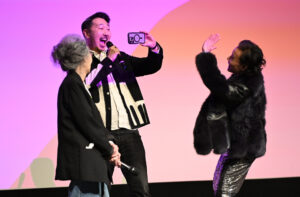Roger Erik Tinch, Digital and Online Media for Sundance Institute
Q: What is your background, how did you begin your journey to film art?
A: I was working in the music industry until they sued Napster. I thought that was a really dumb thing to do, so I started aggressively moving away from that industry. Iʼd already been working with Disneyʼs marketing department, primarily on Pixar films. I had a class with Jules Engel when I was at CalArts, and classes with Don Levy and Gene Youngblood. They introduced me to experimental film directors, people like Stan Brackage, Bruce Conner, Maya Deren. I knew about the Janus film library and Criterion, so I sent some work to them and they hired me.

What’s the hardest project creatively you’ve taken on?
All of them. For different reasons. Criterion, for example, has a very strong editorial voice. The spirit of that voice is to stay as true to the film as possible, try to amplify whatʼs transcendent and timeless about a particular piece. Thatʼs it, trying to get to a solution thatʼs perfectly apropos and innovative, provocative.
Can you describe what interaction or collaboration you typically have with the director of a film?

They’re more familiar with the project early on and have a lot more experience with the property before I come along. My job is gleaning all that information and getting down to the root of what they’re trying to say. It is collaboration, and a relationship, the clients and the directors Iʼve worked with all help make my work so much better.
What is the one thing you wish every producer or marketing exec knew about your process and what leads to an awesome poster?
I donʼt think they need to be burdened with my process. If I want them to know something, Iʼll simply tell them. Itʼs really my job to ask them the right questions and get the information I need to help put me in a position to make an effective ad that will help bring awareness and get people to buy their product.
Are you a film poster collector yourself?
I have some Polish posters that I’ve collected, a few. I think that Polish poster art from the 40s, 50s, 60s is just unbelievable. Any collector should audit Lou Danzigerʼs class at Art Center.

Any thoughts on the current movie poster collector boom?
There are so many talented people out there making beautiful work. The serigraphs out there, the ones people are making for films, remind me of a lot of music poster silk-screens.
Any words of advice to independent filmmakers searching for a way to brand and market their film?

Be true to who you are and what youʼre selling. Try to take all your ideas and marketing solutions from the subject or problem, this way it will be natural and honest and something only you can own. Donʼt be afraid to do something different if you think itʼs right for the film. Read Rollo May’s, The Courage to Create.
I view the “poster” (or making a single representative image) as a necessary exercise. In the same way a successful logo is a single image that represents a large company, it communicates a message about themselves, who they are and what they do. Likewise a poster should sum up what it is you want to message, sell or communicate about your film. Not in 24 frames, not 30 seconds, but one frame. You have one frame to tell me about your film. This process helps bring you to a clearer more concise communication with what it is you’re trying to sell. Whether this single image or frame is manifested as a poster, an electronic ad, a billboard, a DVD cover, etc. it doesn’t matter. It will directly inform all your ad media.







